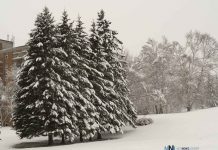 THUNDER BAY – CLIMATE – The establishment of moose in tundra regions of Alaska was the result of warmer and longer summers that increased their shrub habitat, according to a study published April 13, 2016 in the open-access journal PLOS ONE by Ken Tape from the University of Alaska, USA, and colleagues.
THUNDER BAY – CLIMATE – The establishment of moose in tundra regions of Alaska was the result of warmer and longer summers that increased their shrub habitat, according to a study published April 13, 2016 in the open-access journal PLOS ONE by Ken Tape from the University of Alaska, USA, and colleagues.
Moose, an iconic wildlife presence throughout Alaska, were actually absent from its tundra regions earlier in the 20th century. It was previously speculated that overhunting was responsible for this absence.
In the tundra landscape characterized by very short plants, moose must forage on shrubs sticking up above the snow during winter to survive. The authors of the present study therefore wanted to investigate whether a lack of available shrub vegetation was an alternative explanation for the previous absence of moose in the tundra. They used recent changes in shrub cover and relationships between shrub height and summer temperature to estimate the available moose habitat in Arctic Alaska around 1860, to compare it to that available in 2009.
The researchers estimated that average shrub height has increased since 1860 from around 1.1m to around 2m, greatly increasing the available forage sticking up above the snow. They therefore suggest that shrubs prior to the 20th century were too short and sparse in the tundra to support moose. They posit that as shrub habitat has increased as a result of twentieth century warming extending the summer growing season, moose have moved northward into tundra regions.
The average shrub height in 1860 is only an estimate, which is a limitation of the study. Nonetheless, the study provides evidence that shrub availability may explain the 20th century colonization of the tundra by moose. The authors suggest that the northward shift of moose in Alaska by hundreds of miles may be one of the most dramatic wildlife changes linked to climate change.
Ken Tape notes, “Although scientists have been anticipating changes to wildlife in response to the observed changes climate and vegetation of the Arctic, this is one of the first studies to demonstrate it. We showed that the large-scale northward shift of moose was likely in response to their increasing shrub habitat in the tundra.”






